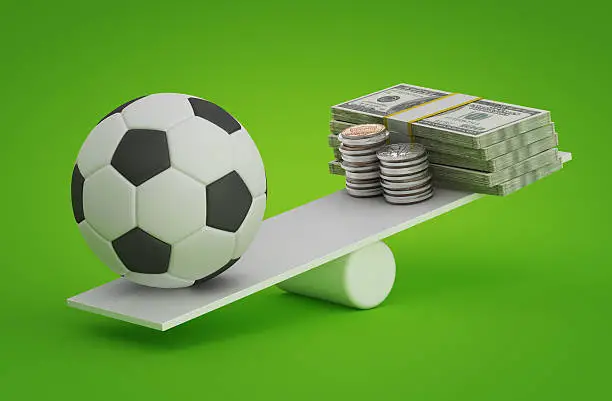Finding funding for sports equipment is an essential aspect of keeping athletic programs thriving, whether you’re running a youth sports league, a school athletics department, or a nonprofit organization focused on physical fitness.
In this guide, we’ll break down the key strategies for securing grants and donations to provide the necessary equipment that ensures athletes have access to quality gear. With the right approach, you can unlock funding opportunities to meet the needs of your program, grow your reach, and give your athletes the tools they need to succeed.
Whether you are a coach, a program director, or part of a nonprofit organization, securing the necessary funds for equipment is crucial. Sports programs often face budget constraints, making it challenging to keep up with rising costs. But don’t worry—there are multiple funding sources available that can help you overcome these financial hurdles.
Understanding the Need for Sports Equipment
Before diving into funding options, let’s quickly outline why sports equipment is so essential. Proper gear not only supports safety, but also boosts performance. Athletes need the right equipment for their respective sports to train, practice, and compete effectively.
For example, football teams need helmets, shoulder pads, and jerseys, while basketball programs rely on quality balls, nets, and shoes.
When these basic necessities are unmet, athletes can be put at risk, which ultimately affects the quality of the program. Investing in top-notch sports equipment enhances both safety and performance, which is a win-win for any athletic program.
Moreover, having modern equipment boosts morale and can lead to higher participation rates. When students and community members see that their sports organizations are well-equipped, they’re more likely to join and support the initiative.
The Broader Impact of Adequate Sports Equipment
Providing proper sports equipment does more than just improve performance and safety. It can:
- Increase Participation: When sports programs are well-equipped, they become more appealing to new members and participants.
- Enhance Community Engagement: Quality equipment can host larger events, draws crowds, and fosters community support.
- Promote Health and Wellness: By ensuring safety and accessibility to proper gear, participants are more likely to engage in physical activities, promoting overall health benefits.
- Develop Team Spirit and Pride: Teams with the latest gear often feel more connected and proud, which encourages dedication and consistent practice.
Knowing this, the search for funding for sports equipment becomes not just a financial exercise but a community-building mission.
Types of Funding for Sports Equipment
1. Grants for Sports Equipment
Grants remain one of the most reliable sources of funding for purchasing sports equipment. They often come from government bodies, private foundations, and organizations that share a vested interest in community development through sports.
a) Government Grants
Local, state, and national government agencies often have provisions to support sports and educational programs:
- Department of Education (DoE): Offers grants under programs like the Safe and Drug-Free Schools and Communities Grant Program, which can sometimes be leveraged to enhance sports programs.
- National Park Service: Occasionally supports community sports initiatives through recreational grants aimed at encouraging outdoor activities.
Example: A local high school leveraged a community development grant from the National Park Service to refurbish its athletic field and purchase new soccer goals, dramatically increasing student participation in sports.
b) Private Foundations
Private foundations are always on the lookout for programs that align with their mission:
- Nike Community Impact Fund: Provides $50,000 to $500,000 to projects that promote community impact through sports.
- DICK’S Sporting Goods Foundation’s Sports Matter Program: Awards grants to youth sports leagues to purchase essential items like uniforms and equipment.
Case Study: The youth basketball league in Springfield received a $25,000 grant from the DICK’S Sporting Goods Foundation, which was used to buy new basketballs and refurbish the local gymnasium, enabling more frequent and effective practices.
c) Corporate Sponsorships
Companies like Nike, Under Armour, and Adidas often engage in sponsorship programs:
- By sponsoring a team or a league, these companies can provide significant equipment discounts or direct donations of gear.
- Sponsorships can also cover branding opportunities such as having the company’s logo on uniforms or banners at events.
When approaching a company for sponsorship, ensure you present a professional proposal detailing how the partnership will benefit both parties. Highlight your community involvement, the number of youths benefiting, and the visibility the sponsor will receive.
2. Crowdfunding Campaigns
Crowdfunding has revolutionized fundraising by democratizing the process:
- Platforms: GoFundMe, Kickstarter, Indiegogo, and others allow you to reach a wide audience.
- Storytelling: Your crowdfunding campaign should tell a compelling story. The narrative is often the most important part—people contribute when they feel emotionally connected.
Tips for a Successful Crowdfunding Campaign:
- Visuals: High-quality photos and videos of your athletes using outdated equipment and the potential benefits of new gear can make your campaign more relatable.
- Social Proof: Share testimonials from players, coaches, and community members who can vouch for the program’s impact.
- Updates: Keep donors informed with regular updates on the campaign’s progress and how the funds will be used.
Example: A community soccer club launched a GoFundMe campaign to replace worn-out soccer balls. Within two weeks, they surpassed their goal thanks to engaging updates, heartfelt stories from players, and community sharing on social media.
3. Corporate Donations and Sponsorships
Beyond formal sponsorship deals, reaching out directly to businesses for donations can yield significant returns:
- Local Businesses: Small, local companies are often eager to support community activities. A local hardware store might donate protective gear for a youth football team.
- Large Corporations: Big brands may not only donate money but also equipment or services, such as shipping or maintenance.
Strategy:
- Research: Identify companies whose values align with your organization.
- Proposal: Craft a personalized request highlighting the mutual benefits of the donation, such as community goodwill and promotional opportunities for the company.
- Follow-Up: After securing a donation, ensure that you acknowledge the contribution publicly, which could encourage further support and build lasting relationships.
Case Study: A local restaurant chain sponsored a summer sports camp by donating funds that allowed the camp to purchase new baseball gear. In return, the camp displayed the restaurant’s banners and distributed coupons, increasing the sponsor’s community visibility.
4. Fundraising Events
Hosting fundraising events is another interactive and community-engaging way to gather funds:
- Charity Tournaments: Organize sports tournaments where participating teams or spectators pay an entry fee.
- Auctions: Silent auctions with donated sports memorabilia or experiences can be both fun and lucrative.
- Community Festivals: Events that include music, food stalls, and sports exhibitions can attract large crowds and generate donations.
How to Plan a Successful Fundraising Event:
- Set Clear Goals: Define how much money you need to raise and what it will be used for.
- Engage Volunteers: A motivated team can handle logistics, outreach, and running the event smoothly.
- Promote Widely: Use social media, local newspapers, and flyers in community centers to spread the word.
- Partner with Local Businesses: They can sponsor parts of the event or provide prizes.
Success Story: An annual “Family Fun Run” organized by a local high school raised over $10,000 by combining a race, a fair, and a sports equipment drive. The funds were then used to purchase new PE equipment for the school.
5. Nonprofit Organizations and Youth Sports Foundations
Organizations with a mission to promote youth development through sports often provide funding:
- The Laureus Sport for Good Foundation: Provides grants to programs that use sports as a tool for social change.
- Local Nonprofits: Smaller organizations or community foundations may have specific funds earmarked for sports equipment.
Action Steps:
- Identify organizations with missions aligning with yours.
- Study their application guidelines and deadlines thoroughly.
- Build relationships with program officers to understand how best to tailor your application.
Example: A nonprofit dedicated to underprivileged youth partnered with the Laureus Sport for Good Foundation to fund a new set of weightlifting equipment. This not only improved the local gym but also provided training that helped youth gain confidence and discipline.
6. School and Local Government Funding
Schools and local municipalities often have hidden sources of funding:
- School Budgets: Look for discretionary funds or specific allocations for extracurricular activities.
- Community Grants: Municipalities sometimes have programs aimed at improving community health and engagement through sports.
Tips:
- Communicate with Administration: Regular meetings with school boards and local councils can help you tap into available funds.
- Apply for Special Programs: Many local governments have annual grant programs specifically for community improvements, including sports facilities and equipment.
Insight: During the COVID-19 pandemic, many schools found creative ways to repurpose technology grants for physical education by purchasing home workout equipment, ensuring students remained active despite lockdowns.
7. In-Kind Donations
Sometimes you can get everything you need without spending a dime:
- Reach Out to Vendors: Contact sporting goods stores that might offer demo equipment or overstock items.
- Use Social Media: Platforms like Facebook Marketplace or community groups can be a goldmine for in-kind offers.
Benefits of In-Kind Donations:
- Cost Savings: Reduces the need for actual cash outlay.
- Immediate Gratification: Equipment can often be delivered faster than waiting for a grant approval.
Example: A local soccer club received an in-kind donation of dozens of soccer balls from a sporting goods retailer looking to clear out older models. This donation significantly reduced their need to spend on new balls, allowing the club to allocate funds to other needs like uniforms.
How to Secure Funding for Sports Equipment
Now that you understand the funding options, how do you secure these resources for your program? Here are a few practical tips:
1. Research and Identify Grant Opportunities
Start by identifying the right grants that align with your needs. Look into organizations such as Sports Foundation or Youth Sports Fund, and explore platforms like GrantWatch or Instrumentl that offer curated lists of available grants. Make sure you match your needs with the grant guidelines.
Steps:
- Identify Your Needs: Create a detailed list of what equipment is required and why.
- Search Grant Databases: Use dedicated search engines and databases to find relevant grants.
- Attend Webinars/Workshops: Many foundations hold informational sessions where you can learn about upcoming opportunities and ask questions.
2. Create a Clear Budget
When applying for funding, always include a clear and detailed budget. Funders want to see how their contributions will be used. Break down the total amount required for equipment, including specific items, quantities, and costs. Also, highlight any other financial support you already have in place to show the funder that you are resourceful and responsible.
Budgeting Tips:
- Use spreadsheets or budgeting software to itemize costs.
- Get quotes from multiple vendors to ensure accuracy.
- Include contingency costs for unforeseen expenses, typically 10-15% of the total budget.
3. Write a Strong Proposal or Funding Request
Whether you’re applying for a grant, writing a letter to a corporate sponsor, or launching a crowdfunding campaign, it’s essential to write a compelling proposal. Explain why your program is deserving of support, outline the impact the equipment will have on your athletes, and describe how the funding will help the community.
Key Components of a Strong Proposal:
- Executive Summary: A concise overview of your funding request.
- Needs Statement: Clearly articulate the problem and why funding is necessary.
- Objectives: Define what success looks like—e.g., increased participation, improved safety.
- Methodology: Outline how the funds will be used, including procurement plans and maintenance.
- Evaluation: Show how you will measure the success of this investment.
If you need help crafting winning proposals, Grant Writing Academy provides expert guidance, templates, and resources to help you succeed. Subscribe to our newsletter to access our tips, strategies, templates, and tools to enhance your success rates! These resources can dramatically increase your ability to secure funding.
4. Leverage Your Network
Reach out to people in your network who may know about funding opportunities or can make connections with potential donors or sponsors. Sometimes, all it takes is a personal introduction to unlock funding that would otherwise be hard to secure.
How to Leverage Your Network:
- Attend Community Events: Build relationships with key stakeholders in your community.
- Join Professional Groups: Organizations like the National Association of Grant Professionals can offer networking opportunities and share insider information on funding.
- Social Media Engagement: Use LinkedIn and Twitter to connect with grantmakers, sponsors, and nonprofit leaders.
Data and Sources on Funding for Sports Equipment
Understanding the landscape of funding is crucial, and grounding your efforts in data can provide compelling points in your proposals:
According to a 2023 report from the National Sports Foundation, the overall spending on youth sports in the U.S. exceeds $17 billion annually, with much of this money being spent on equipment, coaching, and travel. However, a significant percentage of youth sports programs report that they struggle to provide adequate equipment due to financial limitations.
Statistics You Need to Know:
- 80% of youth sports programs report that they rely on external funding to cover the costs of equipment and uniforms.
- 25% of community programs say that in-kind donations are their biggest source of funding.
- Grants make up 45% of the total funds raised for sports equipment in school sports programs.
- The sports equipment market is expected to grow at a compound annual growth rate (CAGR) of 4.3% from 2022 to 2030, indicating rising costs and the need for increased fundraising efforts.
Sources:
These statistics highlight the importance of securing funding to maintain and improve sports programs. They also emphasize the reliance on external funding sources, making it all the more crucial to develop a strong funding strategy.
Success Stories: Real-World Examples
To better illustrate these strategies, let’s look at a few real-world examples of how sports programs successfully secured funding:
Example 1: A Rural School District Revamps Its Athletics Program
A rural school district had outdated and unsafe equipment that limited the success of its sports teams. The athletic director took a multi-pronged approach:
- Applied for several grants from state education funds and local community foundations.
- Organized a charity run that involved students, parents, and the community.
- Sought in-kind donations from local businesses, including a major sports retailer that donated new gym equipment.
Result: Within one year, the district secured over $50,000 in funding, replaced old equipment, and saw a 30% increase in student participation in sports.
Example 2: Community Nonprofit Transforms Youth Sports Access
A nonprofit in an underserved urban area identified a need for basic soccer gear for local youth. They used crowdfunding to raise an initial seed fund and then applied for grants from organizations like the Laureus Sport for Good Foundation. Alongside this, they held community workshops to educate parents and kids about the importance of physical activity.
Result: The nonprofit raised over $100,000, provided equipment to over 500 kids, and built a stronger, healthier community centered around sports.
Leveraging Digital Tools and Resources
In the digital age, various tools can help streamline your fundraising and grant-seeking efforts:
- Grant Management Software: Tools like Foundant or Blackbaud help you manage applications, deadlines, and reporting requirements.
- Budgeting Software: Programs like QuickBooks and Excel can assist in creating detailed budgets.
- Project Management Tools: Platforms like Trello or Asana can help organize tasks, deadlines, and team responsibilities during a fundraising campaign.
By utilizing these digital resources, you can keep your efforts organized, professional, and efficient, which improves your chances of securing funding.
Final Thoughts
Securing funding for sports equipment may seem daunting, but with the right strategies in place, it can be achieved. Whether through grants, sponsorships, crowdfunding, or in-kind donations, there are plenty of opportunities available. By following the steps we’ve outlined, you can ensure that your program gets the equipment it needs to thrive and provide the best possible experience for your athletes.
Remember, being persistent and resourceful is key. The process of securing funding is often cyclical—develop a strong network, continuously research new opportunities, and keep refining your proposals. With each successful campaign, your reputation as a capable fundraiser will grow, opening doors to even more funding opportunities.
Don’t forget—subscribing to Grant Writing Academy‘s newsletter is a great way to stay updated on new funding opportunities and gain access to exclusive tips, strategies, templates, and tools that will increase your chances of success. These resources are designed to enhance your skills in securing funding, helping you navigate the complex world of grants and sponsorships with confidence.
Subscribe now to access exclusive tips, tools, and templates that will help you win grants and secure funding for sports equipment, ensuring your program has all the resources it needs to succeed!
Additional Resources and Support
a) Expand Your Knowledge
The grant writing field is always evolving. Keep learning and improving your skills to stay competitive.
Recommended Resources:
- Request for Proposal Success: How to Write Proposals That Win: Learn the techniques and strategies to create standout proposals.
- Tech Startup Funding Secrets: Navigating Grants for Maximum Growth: Perfect for those in the tech sector looking to leverage grants for scaling.
- Grant Proposal Guide for Environmental Projects: Tailored for environmental initiatives seeking to secure impactful funding.
- The Ultimate Guide to Federal Grant Applications: Techniques for Success: Master the complexities of federal grants with actionable insights.
Explore More Books Here
b) Invest in Expert Guidance
Want to fast-track your growth and achieve even more success?
Join one of our mentorship programs for tailored advice and support:
Mentorship Programs:
- 3-Month Mentorship: The Foundation Builder: A short-term plan to refine your grant writing skills and win your first (or next) grant.
- 6-Month Mentorship: The Proposal Pro: Dive deeper into strategies, proposal reviews, and funding plans.
- 1-Year Mentorship: The Funding Champion: Build long-term success with comprehensive guidance, unlimited reviews, and exclusive resources.
C) Book a One-on-One Consultation
Sometimes you just need personalized advice to tackle challenges or fine-tune your strategy. Let’s work together to solve your unique grant writing challenges.






